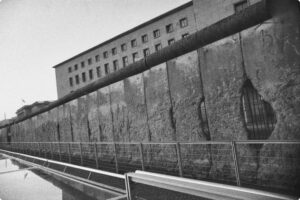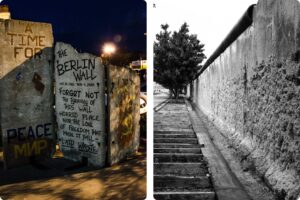The Berlin Wall was a symbol of the division between East and West Berlin during the Cold War. One of the most extraordinary escape stories from this time is Tunnel 57. In October 1964, 57 East Germans successfully escaped to West Berlin through a secret tunnel. In this blog, I’ll share the incredible story behind Tunnel 57 and its significance in the history of the Berlin Wall.
The Background
After the construction of the Berlin Wall in 1961, East Germany was physically and ideologically separated from the West. The East German government claimed the wall was a defense against “imperialist influences,” but in reality, it became a prison for millions of East Germans. Many sought opportunities, freedom, and a better life in the West. Despite the formidable barriers of barbed wire, armed soldiers, watchtowers, and constant surveillance, East Germans constantly tried to find ways to escape.
One of the most remarkable escapes took place in 1964 through Tunnel 57, an audacious underground route from East to West Berlin.
The Plan for the Tunnel
The idea for the tunnel came from Wolfgang Fuchs, a young West German student and activist. In 1964, Fuchs and his friends decided to dig an underground tunnel to smuggle East Germans to the West. They raised money, gathered materials, and started digging in September 1964. The group worked tirelessly, often risking discovery by the Stasi, the East German secret police who were constantly monitoring for escape routes.
The tunnel stretched about 145 meters, starting from an abandoned building in West Berlin and ending in an empty house in East Berlin. Constructing the tunnel was a grueling task, both physically and emotionally. The team had to navigate the cramped space, monitor for potential collapses, and, of course, avoid detection by the Stasi.
The Great Escape
On the evening of October 3, 1964, the tunnel was ready, and the escape was set in motion. As night fell, 57 East Germans, including families and friends, lined up to escape to the West. The escape unfolded relatively smoothly, but the tension among the refugees was palpable.
At one point, the tunnel was nearly discovered by East German border guards. A guard and a young Stasi soldier noticed unusual activity in the abandoned building where the tunnel ended. When they entered, they discovered the entrance. A gunfight broke out, during which the Stasi soldier was killed. Despite the close call, the escape continued, and the 57 people successfully made it to West Berlin.
The Aftermath
Tunnel 57 was one of the largest and most successful escapes during the time of the Berlin Wall, garnering worldwide attention. For the East German government, it was a humiliation, prompting even stricter border security measures by the Stasi. For those who escaped, it meant a new life and freedom in the West—but it also meant leaving behind family and loved ones in East Berlin.
Discover Berlin’s Rich History
If you want to learn more about Berlin’s fascinating and sometimes dark history, be sure to check out SmartWalk Berlin. Explore the historical sites related to the Berlin Wall at your own pace, while taking breaks whenever you need to.
Prepare for Your Trip to Berlin
Ready to visit Berlin? Don’t miss out on our blog about the best practical tips for your trip to Deutschland, ensuring you’re fully prepared for an unforgettable experience in this historic city!






